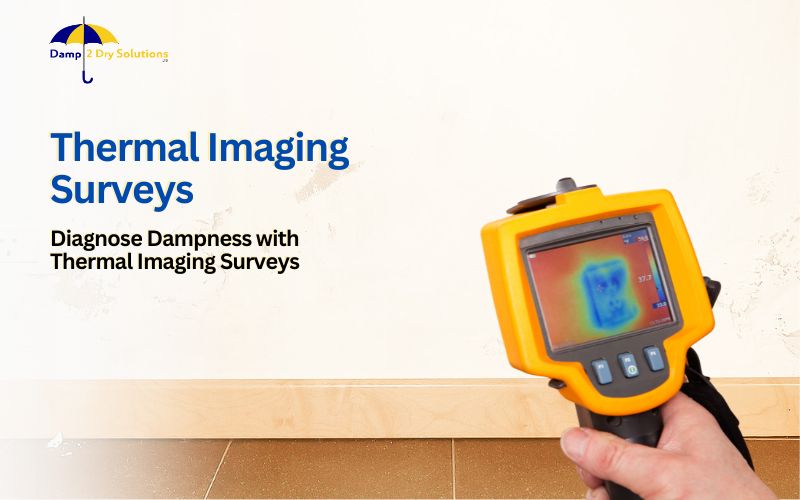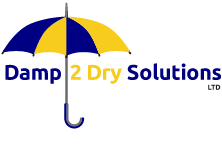
Early identification of damp and cold bridging is crucial for preserving a building’s condition and value.
Damp can silently damage your property. Traditional checks often miss hidden problems, leading to costly repairs. Thermal imaging can solve this problem.
Thermal imaging technology detects dampness by revealing temperature differences. Areas with moisture appear cooler on a thermal image. Early detection means quicker action, preventing worse problems.
If you suspect dampness, a thermal imaging survey can pinpoint the issue. This non-invasive method saves time and money by targeting problem areas accurately.
Let’s explore how thermal imaging works in more detail.
What is a Thermal Imaging Survey?
A thermal imaging survey is a way to inspect buildings for signs of dampness. It’s a non-invasive method, meaning it doesn’t harm the property.
The survey uses thermal cameras to detect temperature changes in the building. These temperature differences show up as images.
The images reveal areas where heat is lost or where moisture is present. The survey works by capturing infrared radiation from objects.
Infrared radiation is a type of heat energy that all objects emit. The thermal camera translates this radiation into images that we can see.
These images show details about the temperature, shape, and surface of the surveyed area. By analysing these images, it’s possible to identify dampness and other issues that might not be visible to the naked eye.
Why is dampness a problem?
Dampness in buildings can lead to several problems. First, it weakens the structure of the building. Over time, moisture can cause wood to rot, metals to rust, and plaster to crumble. This structural damage will be expensive to repair and may even make the building unsafe.
Second, dampness may lead to the growth of mould and mildew. Mould flourishes in moist environments and can spread quickly. Not only is mould shabby, but it can also pose health risks.
Mould exposure can cause respiratory problems, allergies, and other health issues, especially for people with asthma or weakened immune systems.
Finally, dampness can reduce the value of your property. If you’re trying to sell a home or rent out a property, visible signs of dampness or mould can deter potential buyers or tenants. Even if the dampness isn’t visible, it can still affect the property’s value if it’s detected during an inspection.
Where does the thermal imaging survey take place?

Thermal imaging surveys are widely used in various fields, including:
- Building inspections: Finding heat loss, insulation defects, moisture source & problems, structural issues, etc.
- Electrical systems: Detecting overheating components, electrical faults, and energy inefficiencies.
- Mechanical equipment: Identifying overheated bearings, motor problems, and heat-related issues.
- Construction: Assessing building envelope integrity, detecting air leaks, and evaluating insulation performance.
- Environmental monitoring: Identifying heat sources, pollution, and changes in land temperature.
Why use thermal imaging for diagnosing dampness?
One of the most important applications of using the thermal imaging survey is to detect and diagnose building and other infrastructure dampness.
Traditional methods, like visual inspections or moisture meters, may only sometimes detect hidden dampness. This is where thermal imaging comes into the picture. It can identify moisture in walls, floors, and ceilings without invasive testing.
Since dampness is unavoidable, consideration must be given to avoid structural damage, the growth of mould, and other issues.
Here’s why thermal imaging is a valuable tool for detecting dampness:
- Early Detection: Thermal imaging can detect dampness before it becomes visible. This allows you to take action early, preventing further damage and reducing repair costs.
- Non-Invasive: Unlike some traditional methods, thermal imaging doesn’t damage the property. The survey can be conducted quickly and without disrupting the occupants.
- Accurate Results: Thermal imaging provides precise information about where dampness is located. This means that repairs can be targeted exactly where they are needed, saving time and money.
- Extensive Coverage: This heat loss survey quickly covers large areas, making it perfect for both large commercial buildings and small homes.
- Mould Prevention: By detecting dampness early, thermal imaging helps prevent mould growth. This is important for maintaining a healthy living environment and avoiding potential health risks.
How Does Thermal Imaging Work?
Thermal imaging cameras and equipments detect infrared radiation, which is a form of heat. All objects emit infrared radiation, but the amount they emit varies depending on their temperature.
The thermal camera captures this radiation and translates it into images that show temperature differences.
In the thermal images, warmer areas appear in red, orange, and yellow shades. Whereas, the cooler areas are shown in blue, green, and purple.
When we (Damp2Dry Solutions) survey a building, areas with moisture typically appear cooler because water retains heat longer than most building materials.
We use a thermal camera to scan the property, focusing especially on areas where moisture is most likely to occur, such as basements, bathrooms, kitchens, and areas around windows and doors.
After completing the survey, we analyse the images to identify any unusual temperature patterns that may indicate the presence of moisture.
Who Should Consider Thermal Imaging Survey
Thermal imaging surveys are beneficial for a wide range of people:
- Homeowners: If you suspect dampness in your home, a thermal imaging survey can confirm the issue and help you address it before it worsens.
- Landlords and Property Managers: Regular thermal imaging surveys can help maintain the quality of your properties and prevent serious damp issues from developing, protecting your investment and ensuring a safe living environment for tenants.
- Construction Professionals: Builders and contractors can use thermal imaging to check the quality of their work, particularly insulation and the integrity of the building envelope. This helps ensure the building meets energy efficiency standards and is free from defects.
- Real Estate Investors: Before purchasing a property, a thermal imaging survey can reveal hidden issues that might affect the property’s value or require expensive repairs.
- Insurance Companies: Insurers may use thermal imaging surveys to assess the condition of a property before providing coverage, and also in the event of a claim related to damp or water damage to determine the extent of the damage.
About Us
For expert damp proofing and independent damp surveys, choose Damp 2 Dry Solutions Ltd. Our team of specialists delivers comprehensive assessments and effective treatments to keep your home dry and healthy.
We proudly serve Cheshire, Manchester & Lancashire, Liverpool & Merseyside, Warrington, Chester, Stoke-on-trent, and the surrounding areas. In these regions, we offer a no-obligation damp survey.
Contact Damp 2 Dry Solutions today to schedule your consultation!
Conclusion
Thermal imaging surveys are a powerful tool for detecting dampness and other issues in buildings.
They offer a non-invasive, accurate, and comprehensive assessment, allowing property owners and professionals to identify problems early. This can prevent costly repairs, ensure the safety of the building, and maintain its value.
Whether you are a homeowner, landlord, construction professional, or real estate investor, considering a thermal imaging survey is a wise investment.
By understanding how thermal imaging works and the benefits it offers, you can make informed decisions about maintaining your property and protecting it from the damaging effects of dampness.
